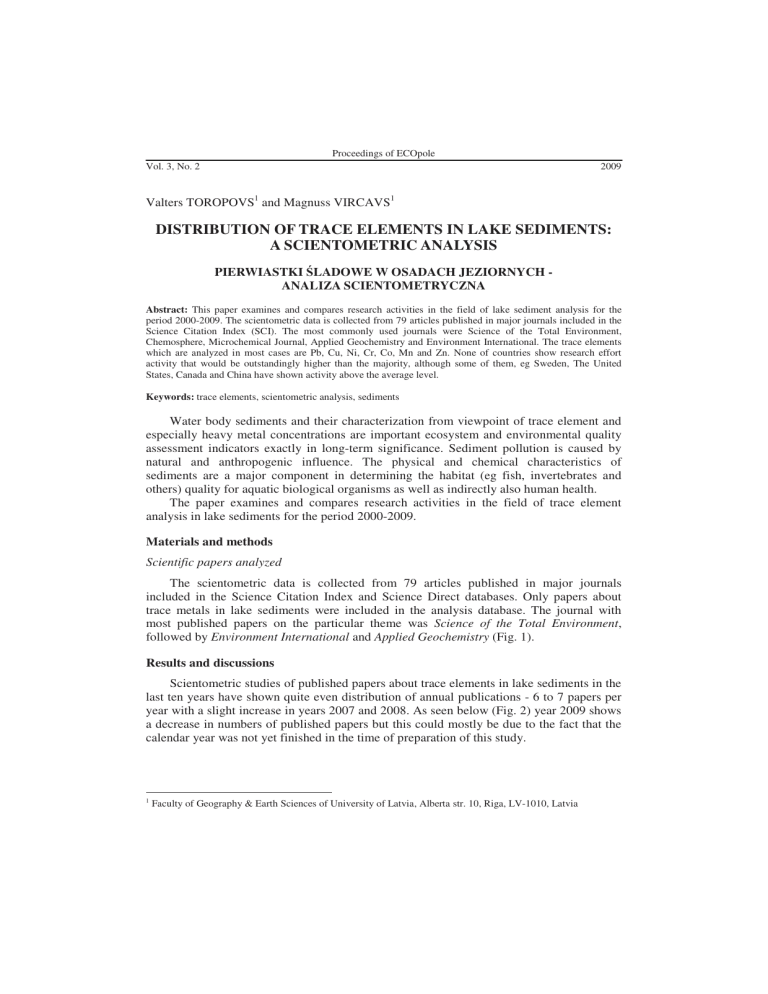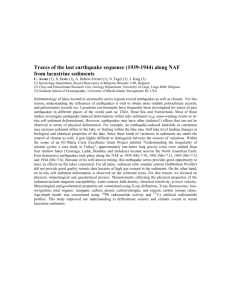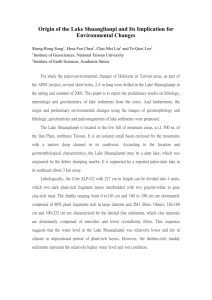
Proceedings of ECOpole Vol. 3, No. 2 2009 Valters TOROPOVS1 and Magnuss VIRCAVS1 DISTRIBUTION OF TRACE ELEMENTS IN LAKE SEDIMENTS: A SCIENTOMETRIC ANALYSIS PIERWIASTKI LADOWE W OSADACH JEZIORNYCH ANALIZA SCIENTOMETRYCZNA Abstract: This paper examines and compares research activities in the field of lake sediment analysis for the period 2000-2009. The scientometric data is collected from 79 articles published in major journals included in the Science Citation Index (SCI). The most commonly used journals were Science of the Total Environment, Chemosphere, Microchemical Journal, Applied Geochemistry and Environment International. The trace elements which are analyzed in most cases are Pb, Cu, Ni, Cr, Co, Mn and Zn. None of countries show research effort activity that would be outstandingly higher than the majority, although some of them, eg Sweden, The United States, Canada and China have shown activity above the average level. Keywords: trace elements, scientometric analysis, sediments Water body sediments and their characterization from viewpoint of trace element and especially heavy metal concentrations are important ecosystem and environmental quality assessment indicators exactly in long-term significance. Sediment pollution is caused by natural and anthropogenic influence. The physical and chemical characteristics of sediments are a major component in determining the habitat (eg fish, invertebrates and others) quality for aquatic biological organisms as well as indirectly also human health. The paper examines and compares research activities in the field of trace element analysis in lake sediments for the period 2000-2009. Materials and methods Scientific papers analyzed The scientometric data is collected from 79 articles published in major journals included in the Science Citation Index and Science Direct databases. Only papers about trace metals in lake sediments were included in the analysis database. The journal with most published papers on the particular theme was Science of the Total Environment, followed by Environment International and Applied Geochemistry (Fig. 1). Results and discussions Scientometric studies of published papers about trace elements in lake sediments in the last ten years have shown quite even distribution of annual publications - 6 to 7 papers per year with a slight increase in years 2007 and 2008. As seen below (Fig. 2) year 2009 shows a decrease in numbers of published papers but this could mostly be due to the fact that the calendar year was not yet finished in the time of preparation of this study. 1 Faculty of Geography & Earth Sciences of University of Latvia, Alberta str. 10, Riga, LV-1010, Latvia 384 Valters Toropovs and Magnuss Vircavs Fig. 1. 10 journals with most published papers on subject of trace metals in lake sediments from 2000-2009 120 Number of papers 100 80 Number of published papers 60 Cumulated published papers 40 20 0 2000 2001 2002 2003 2004 2005 Year 2006 2007 2008 2009 Fig. 2. Number of published papers per year on topics related to trace elements in lake sediments Most commonly analyzed elements The papers that have been written in the recent years could be arranged elementwise according to the amount of work carried out on it. Using this criterion, Figure 3 shows that the most studied elements in lake sediments are Zn, Pb, Cu, Cr, Cd, Mn and Ni [1]. The noted trace elements evidently sufficiently characterize sediment pollution level. Distribution of trace elements in lake sediments: a scientometric analysis 385 Fig. 3. Distribution of published works on the distribution of elements in lake sediments, as a function of elements involved Sample collection specifications Sample collection for analysis can be divided into two major groups according to the goal of the study - deep core samples (>50 cm, reaching 193 cm and more) if study is focused on geochronology or palaelohydrology [2, 3] and shallow core samples (<50 cm) or just the upper layer of sediments if the study focuses on metal composition, distribution, impact assessment or other similar objectives [4-6]. It can be noted that no certain depth of analysis is used by majority of researchers - every individual scientist chooses this parameter by their own technical and scientific possibilities. Naturally, also different geographical, climatic and hydrological aspects are taken into account, as well as the rate of sedimentation in each particular research site. Treatment and methods of analysis of collected samples As general methods for analysis of trace elements, three most common can be pointed out - inductively coupled plasma mass spectrometry or atomic emission spectrometry (ICP-MS/AES), atomic absorption spectrometry (AAS) and X-ray fluorescence. In majority of cases HNO3, HCl and HF in different proportions have been used to acidify the collected samples for further analysis [7, 8]. In separate cases instrumental methods of analysis have been used as well (analyzing collected samples without further pretreatment or dissolving) but this is a distinct minority - only 15÷20% of total research studies have utilized such an approach. This fact could indicate both increased reliability and simplicity of chemical analysis methods. Regional distribution of studies None of countries show research effort activity that would be outstandingly higher than the majority, although some regions, eg North America have shown activity above the 386 Valters Toropovs and Magnuss Vircavs average level. In past few years Chinese scientists have shown increased activity in researching this field as well. Conclusion Scientometric analysis of published scientific papers on the subject of trace elements in lake sediments in years 2000-2009 have shown that journal with most published articles on this topic is Science of the Total Environment (9 papers), while most commonly studied elements were Zn, Pb, Cu, Cr, Cd, Mn and Ni. Depths of sediment layers collected for samples varied greatly amongst analyzed papers starting from 2 cm and going up to 193 cm and more. Undoubtedly predominant methods of sample analysis were ICP-MS/AES, AAS and X-ray fluorescence. References [1] [2] [3] [4] [5] [6] [7] [8] Horowitz A.J.: Determining annual suspended sediment and sediment-associated trace element and nutrient fluxes. Sci. Total Environ., 2008, 400, 315-343. Ng S.L. and King R.H.: Geochemistry of lake sediments as a record of environmental change in a high arctic watershed. Chem. Erde, 2004, 64, 257-275. Tanaka K. et al: Rare earth element geochemistry of Lake Baikal sediment: its implication for geochemical response to climate change during the Last Glacial/Interglacial transition. Quartern. Sci. Rev., 2007, 26, 1362-1368. Outridge P.M. et al: Trace metal profiles in the varved sediment of an Arctic lake. Geochim. Cosmochim. Acta, 2005, 69(20), 4881-4894. Chalmers A.T., Van Metre P.C. and Callender E.: The chemical response of particle-associated contaminants in aquatic sediments to urbanization in New England, U.S.A. J. Contam. Hydrol., 2007, 91, 4-25. Li R.Y. et al: Fractionation of heavy metals in sediments from Dianchi Lake, China. Pedosphere, 2007, 17(2), 265-272. Tuncer G., Tuncel G. and Balkas T.: Evolution of metal pollution in the Golden Horn (Turkey) sediments between 1912 and 1987. Marine Pollut. Bull., 2001, 42, 350-360. Shuchun Y. et al: Lead pollution recorded in sediments of three lakes located at the middle and lower Yangtze River basin, China. Quatern. Int., 2009, 1-6. PIERWIASTKI LADOWE W OSADACH JEZIORNYCH ANALIZA SCIENTOMETRYCZNA Abstrakt: W pracy przedstawiono analiz scientometryczn wyników bada osadów dennych pobranych z jezior w latach 2000-2009. Analizowano wyniki bada , które były przedstawione w 79 artykułach publikowanych na łamach najwa niejszych czasopism zawartych w Science Citation Index (SCI). Najcz ciej cytowane były czasopisma: Science of Total Environment, Chemosphere, Microchemical Journal, Applied Geochemistry oraz Environment International. W wi kszo ci prac przedstawiono wyniki oznacze pierwiastków ladowych, m.in.: Pb, Cu, Ni, Cr, Co, Mn i Zn. W adnej z prac nie stwierdzono zbyt du ych st e , chocia w niektórych krajach, np. w Szwecji, Stanach Zjednoczonych, Kanadzie i Chinach, stwierdzone st enia były wi ksze od warto ci redniej. Słowa kluczowe: pierwiastki ladowe, analiza pomiarów naukowych, osady







